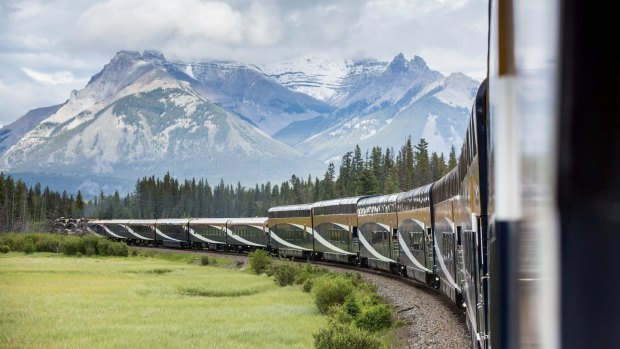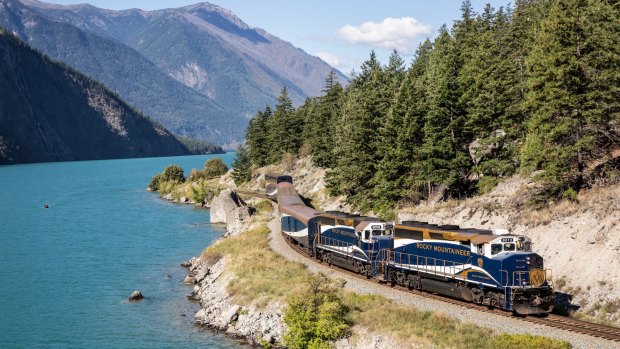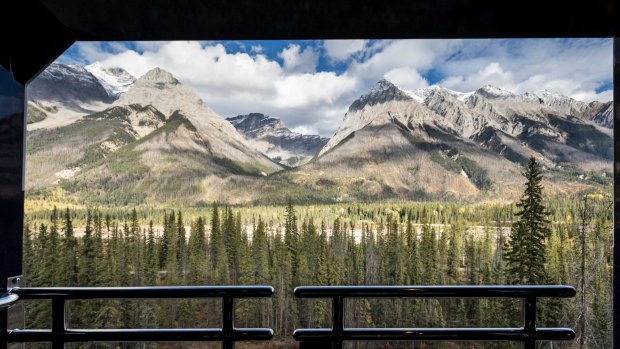This was published 4 years ago
Train travel through Canada: Rolling through the Rockies on the Rocky Mountaineer
By Keith Austin

View of Canada's stunning landscape from The Rocky Mountaineer.
The human eye, explains a fellow passenger on the Rocky Mountaineer train as we chug through British Columbia, can perceive more hues of green than any other colour. This is just as well as there's an awful lot of the stuff outside.
Trouble is, most of it is on the trees lining the tracks and they're getting in the way of the mountains I want to photograph. Honestly, sometimes there's just too much nature getting in the way of the nature. Or as the lady on the outdoor vestibule tutted: "Next time I'm bringing an axe."
And so begin two days – from Vancouver on Canada's west coast to Banff in Alberta's Rocky Mountains – in which myself and 689 of my closest friends indulge in food, drink, photography, nature, general bonhomie and more bald eagles than you can poke a stick at (honestly, the things are like pigeons here).

The Rocky Mountaineer train passes beside Seton Lake along the Rainforest to Goldrush route.Credit: Rocky Mountaineer
Our journey starts on a bright blue morning with a hint of ice in the air. A 10-minute drive from the hotel brings us to the cavernous main reception hall by the tracks where the 26 coaches that make up the Rocky Mountaineer (RM) are waiting.
There's a souvenir stand in the hall, liveried staff handing out soft drinks, and an energetic chap bashing out a honky-tonk version of Bohemian Rhapsody on a grand piano before moving on to the Game of Thrones theme tune.
There's a short speech, a whistle is blown, and then come those all-important words: All aboard!

Viewing car on the Rocky Mountaineer.Credit: Rocky Mountaineer
Since 1990 RM trains have carried 2 million people – and it shows in the professionalism of the staff and the slick way they usher almost 700 excited, slack-jawed, happy-snapping holidaymakers onto the carriages without seeming to "usher" at all.
The RM is what's called an all-dome fleet, which means that whatever class you travel in (GoldLeaf or SilverLeaf) the carriages have magnificent all-round views. GoldLeaf carriages are double-deckers and have a separate dining car downstairs while SilverLeaf carriages are single-deckers and meals are served at your seat.
Our trip is taking us from Vancouver to the city of Kamloops, where we will overnight, and then on to Banff in Alberta. On both days we will be on the train for 12 hours which, looking forward, seems excessive but which, looking back, was barely enough.
As we pull out of the train yards and start to rumble slowly through the backblocks of Vancouver, our attendants explain that breakfast and lunch will be taken in two sittings. Here in GoldLeaf this means half of us head downstairs to the dining car (each carriage has its own narrow kitchen from which, somehow, pop delicious three-course gourmet meals) while the other half must wait.
There's a cruel twist to this waiting lark; those of us who must bide our time are forced to consume a pre-breakfast breakfast of jam and scones with coffee or tea. Much the same is true of lunch, when the pre-lunch lunch consists of cheese, dried fruit and wines.
This is all to say that nobody goes hungry or thirsty. And you've got to love it when, as you hesitate over ordering a beer at 10am, your attendant points out that it's noon somewhere in the world.
The next two days are a vast and luxurious kaleidoscope of images that at times defy coherent thought. This is summed up by one passenger who, as we stand in a freezing, open-air vestibule watching another panoramic mountain vista reveal itself, mutters: "This is mad, mental, mental."
The section of the trip from Vancouver to Kamloops is the less gobsmacking of the two but this is only in comparative hindsight because the second day sees us head into the Rockies themselves.
From our self-contained bubble, we watch as the suburbs gradually peter out and are replaced by the wide valleys and rivers of British Columbia. There is farmland on both sides, cable-stay bridges above broad rivers on which massive logs float, and sawmills surrounded by lumber and mounds of sawdust.
We see a couple of bears thanks to an early warning system whereby sightings are relayed along the train through our attendants' headsets. And all the time, off in the distance, we can see the snowy mountains that are our ultimate goal.
Eventually the plains become less frequent – though there are still cattle and ginseng farms up here – and we start to experience gorges and tunnels carved under the foothills of this astonishing mountain range. We pass Rainbow Canyon, Avalanche Alley and the white-water rapids known as Hell's Gate.
From the attendants we learn about the indigenous people, about the history and geography of the area, and get plenty of warning when a bear is sighted or an osprey nest atop a telegraph pole is coming up on the right-hand side.
On the approach to Kamloops, with the sun just starting to set, we see bighorn sheep, and Louis Armstrong's What a Wonderful World is piped through the carriage. As first days go, it's not a shabby way to finish.
The Rocky Mountains were first mentioned by a European in 1752, in the journal of a chap called Jacques Legardeur de Saint-Pierre. For someone with a name that could choke a grizzly he wasn't much cop in the imagination department and described his surroundings as "Montagnes de Roche", which I'm assuming needs no translating.
We start day two early and, after watching the train ease magnificently into Kamloops station, are on the road by 7am, scoffing buttered scones and marvelling at rock formations that echo the Wild West of old cowboy movies.
It has, we are told, been snowing in Banff and we can expect to arrive that night in a "winter wonderland". Certainly, the higher peaks we see in the distance are dusted with a caster sugar sprinkle and the air is much colder despite the cloudless sky.
We trundle through Sicamous, the "houseboating capital of Canada", catch sight of more bears, pass by wide lakes, stony creek beds and rivers that gradually lose their crystal clarity in favour of the slightly milky hue that hints of snow runoff. We are in sockeye salmon country, an area of winter sports, 15 metres of snow annually and yet more bloody eagles.
Through the city of Revelstoke, overlooked by the great mass of Mount Begbie, the canyons we pass along are steeper, the bends more acute, the rivers wilder and the tunnels longer.
And as the landscape grows so does the general excitement. Though perhaps that isn't the mot juste, as Monsieur Saint-Pierre might have said. For me, it's excitement mixed with something else, something I'd call awe if "awesome" hadn't been hijacked to mean "nice socks, man".
These jagged, ragged, wild and wonderful montagnes de roche with their sheer cliff faces, steep sides covered in the dark and serried ranks of fir trees all dusted with end-of-season snow, are humbling.
And that's how I got off in Banff at 7.30pm, under light snow flurries; humbled, excited and sad to leave but full of Canadian scotch and the cinnamon-oatmeal-raisin cookies the chefs knocked up on the last stretch of the journey.
No, not too shabby at all.
TRIP NOTES
FLY
Air Canada flies daily to Vancouver from Sydney, Brisbane and Melbourne; our flight returned from Calgary with a short stop in Vancouver. See aircanada.com/au
TOUR
Rocky Mountaineer runs four routes – the Coastal Passage, Rainforest to Gold Rush, Journey Through the Clouds and First Passage to the West – from Vancouver or Seattle to Lake Louise, Banff, and Jasper. Trips can be mixed and matched and take anything from two to 14 days. The routes are closed mid-October to mid-April. New options in 2019 include a self-drive package from Banff to the mountain hideaway of Pomeroy Kananaskis Mountain Lodge (lodgeatkananaskis.com) and a combination of rail and sail with an Alaskan cruise.
The First Passage to the West journey includes a Vancouver lookout tour, two breakfasts and two lunches on the train, complimentary beverages, rail transfers, luggage handling and hotel accommodation in Vancouver, Kamloops and Banff. A five-day tour starts at $C2499 per person; see rockymountaineer.com
MORE
Keith Austin travelled as a guest of Rocky Mountaineer.
Sign up for the Traveller Deals newsletter
Get exclusive travel deals delivered straight to your inbox. Sign up now.